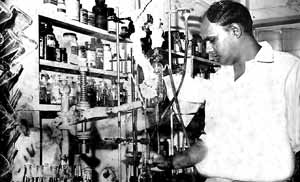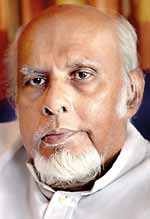The discussion at the Biochemistry Department on the top-most floor of the Sri Jayewardenepura University’s Library Building is on food and their link with diseases such as diabetes. A name which keeps cropping up, however, is of someone who no longer works there, but has been awarded Emeritus Professor status in 2008.
 |
| Young Jansz conducting one of his first projects at the CISIR in 1968. |
It is that of Emeritus Professor Errol Radcliffe Jansz, 70, and it was in recognition of his invaluable service that he was honoured recently with the highest award from the university – the Doctor of Science (honoris causa), probably the first from among the minorities to be showered with this accolade by Sri Jayewardenepura.
In a sense, it is ironic that though he is a Burgher (he calls himself a “black” Burgher), he focused on the palmyrah, going against the tide of the times. For at that time eyebrows were raised why it was palmyrah, and not coconut.
Heading the only team of scientists in the south to work on palmyrah research, Prof. Jansz had also been surprised to find that even a northerner was reluctant to be part of it. Although it boiled down to caste, with only people from low castes at that time engaging in palmyrah work, there had been no hesitation on the part of the Jaffna University to award Prof. Jansz the Prof. K. Balasubramaniam gold medal while the Palmyrah Board honoured him with the ‘Ponnade’ (golden shawl) and the Palmyrah Shield in 2003.
For, Prof. Jansz and his team brought out the value of this ‘tree of life’, the Sunday Times understands, by isolating and naming the fruit pulp components and uncovering several bio-active effects. A major finding, according to him, is that palmyrah fruit pulp reduces both cholesterol and blood sugar.
“Another component is an antibiotic proven to act against pathogens in hospital wounds,” says Prof. Jansz, stressing that this was an antibiotic to which bacteria had not developed resistance. “It was entirely novel.”
 |
Prof. Jansz. Pic by
M.A. Pushpa Kumara |
His team also made a breakthrough when it not only identified the neurotoxin of palmyrah flour which had evaded identification since 1973 but also found methods for its detoxification. Another discovery by Prof. Jansz was that palmyrah flour was effective against the larvae of the dengue mosquito, points out his wife, Oranee, adding that many more findings were incorporated into industries in the north.
For his groundbreaking work, Prof. Jansz had also been awarded the Bernard Soysa gold medal after he delivered the Bernard Soysa Oration titled, ‘Unravelling the mysteries of palmyrah’.
It was not only palymrah that he worked on but also other common foods in the country, uncovering the property of lowering blood sugar in kankun (Ipomoea aquatica), kara (Canthium coromandelicum) and kuruncha (Gymnema lactiferum). “The latter two also reduce bad blood lipids,” he says.
Many are the misconceptions that he has also dispelled, one being the view that goraka could prevent the lowering of the allergenic effect of the balaya fish.
He recalls his findings with regard to papaw and carrot – that the best pro-vitamin A carotenoids are found in them but overdosing would cause 2-5% of children to turn yellow (hypercarotenaemia). “This is a genetic factor and is easily reversed by withdrawing these foods,” he says.
Like the questions raised when he decided to research the palmyrah tree, controversy has dogged his career, especially during his time at the CISIR (Ceylon Institute of Scientific and Industrial Research), after which he joined the Sri Jayewardenepura University not only setting up its Biochemistry Department but taking it to unimaginable heights.
Before those tumultuous years, however, Prof. Jansz goes down memory lane to his boyhood at Royal College. He was a victim of bad health, being laid up frequently and once so very ill that a priest had been called to perform the last rites. With nephritis keeping him away from school, it was only later that his academic abilities surfaced.
Illness was not his only foe – although born a left-hander, his teachers’ insistence that he follow the herd and write with his right hand made the boy develop a stammer. “I spoke little and that too softly,” says Prof. Jansz, adding that he still does the same.
Gradually, chemistry became his passion and although his father’s desired path for him was medicine, he mischievously says that to avoid it he simply skipped the organic paper of Chemistry to get lower marks, unbeknown to his father. He entered the University of Ceylon to do Biology. “In the first year I qualified to do all three special degrees – Chemistry, Botany and Zoology,” he says but it was Chemistry that won the day. He then moved to Peradeniya to do his finals, where his wife-to-be, Oranee, had preceded him to specialize in Chemistry.
The towering young Errol at 6’1”, however, was no nerd, taking up weight training and also taking part in putt-shot events. As opening bat for Arunachalam Hall, his team had won the match, while a week before the final exams he had bagged the Gold Cup as Weightlifting Champion in 1966.
Completing his degree as a Chemistry Special graduate, he says he was the “first choice” when it came to selecting an Assistant Lecturer for the Colombo campus to be in charge of the practicals for the General Science Qualifying Examination. That he was “doing a good job” was apparent when among the three batches of 120 students he taught, 70 secured As whereas the norm had been only about five to 10 in a batch.
When the university was in the throes of a strike, Prof. Jansz had decided to call it quits and follow his dream of becoming a research scientist.
Acting on the spur of the moment he had called the then Director of the CISIR, Dr. George Ponnamperuma who simply said, “Come join us”, sans advertisements to fill the post.
Placed in the microbiology section of the CISIR under expert, Edwin JeyaRaj who was also a trade union leader, there had been much suspicion that his appointment was through influence because at that time, Prof. Jansz’s father, S.E.P Jansz was the Exchange Controller. “Incidentally, my father would go on to become Senior Deputy Governor of the Central Bank and write the Act setting up the National Savings Bank (NSB) in 1971,” says Prof. Jansz, referring to the current controversy the NSB is embroiled in.
In just three months, however, he had proven his mettle and he and JeyaRaj had become the best of friends until his death in 1988.
Emotion overwhelms him even so many years later when Prof. Jansz recalls the day Jeya, as he fondly called him, recovering from a prostate operation at the General Hospital told him, “My son, I knew you would reach the top but not so fast.”
By that time Prof. Jansz was Director of the CISIR. “Jeya who taught me microbiology and gave me all the books I needed, died that night,” he sighs.
Another weapon in his armoury that enabled him to reach the Director’s chair was the Commonwealth Scholarship for Biochemistry awarded by Dalhousie University in Canada. This saw him being mentored not only by academics at the well-known Charles Tupper Medical School but also Prof. Ian MacClean whom he calls the best human being he has ever met which resulted in him naming his second daughter Ianthi.
“Those were the days when biochemistry in Sri Lanka was atrocious. But around the world, the late 1960s was the golden era of biochemistry with metabolic pathways being worked out and DNA being unravelled,” he says.
With his doctoral thesis “with very few corrections” being a model in 1972, it was while at the CISIR that he “managed to save Sri Lankans going the African way”.
“The Africans were eating manioc as a staple and it was Dr. Brighty de Mel and I who were bold enough to point out that eating manioc daily would result in goitre and ataxic neuropathy. Take off the toxins before eating manioc, we advised.”
All Prof. Jansz’s contributions are too numerous to mention and would require reams but political reasons saw him being moved out as the Director of the CISIR, now known as the ITI (Industrial Technology Institute), leading to the gain of the Sri Jayewardenepura University.
With more than 130 papers in prestigious journals, 15 monographs and more than 150 scientific communications, he has also been bestowed recognition in many international biographies such as the ‘Marquis Who’s Who of the World’ from 1997 to 2012. The International Biographical Centre, Cambridge, England, has namedhim one of the top 10 scientists globally in 2011 and selected him as one of the recipients of the Iconic Einstein Award in 2011 for a life-time contribution to science. He has also been nominated as the International Scientist of the Year for 2012.
Now living in retirement down Pietersz Place at Kohuwela, not only growing his own coffee but also processing it, steaming cups of which we had just sipped, it is, therefore, not surprising that when Sri Jayewardenepura University honoured him recently there was no mild applause – but a standing ovation.
|



